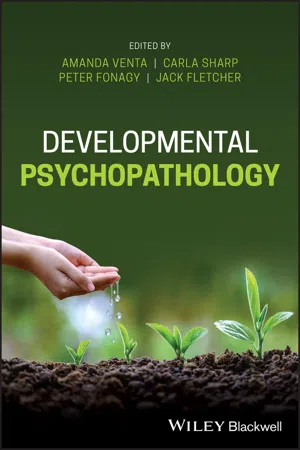
Developmental Psychopathology
- English
- ePUB (mobile friendly)
- Available on iOS & Android
Developmental Psychopathology
About this book
The mainstream upper-level undergraduate textbook designed for first courses in Developmental Psychopathology
Developmental Psychopathology provides a comprehensive introduction to the evolving scientific discipline that focuses on the interactions between the biological, psychological, behavioral, and social contextual aspects of normal and abnormal human development. Designed for advanced undergraduates and early graduate students with no previous engagement with the subject, this well-balanced textbook integrates clinical knowledge and scientific practice to help students understand both how and why mental health problems emerge across the lifespan.
Organized into four parts, the text first provides students with essential background information on traditional approaches to psychopathology, developmental psychopathology (DP), normal development, and insecure attachment. The next section addresses attention-deficit/hyperactivity disorder (ADHD), autism spectrum disorder (ASD), and other problems emerging in childhood. Part III covers problems that arise in adolescence and young adulthood, such as depression, suicide, eating disorders, and schizophrenia. The text concludes with a discussion of special topics such as the relation between pathopsychological issues and divorce, separation, and loss. Each chapter includes a visual demonstration of the DP approach, a clinical case, further readings, and discussion questions. Developmental Psychopathology:
- Presents a coherent organization of material that illustrates the DP principle of cutting across multiple levels of analysis
- Covers common psychopathological problems including antisocial behavior, substance use disorders, fear and anxiety, and emerging personality disorders
- Features integrative DP models based on the most recent research in psychopathological disorders
- Provides instructors with a consistent pedagogical framework for teaching upper-level students encountering the discipline for the first time
Developmental Psychopathology is the perfect textbook for advanced undergraduate or graduate courses in Child Psychopathology, Abnormal Child Psychology, Clinical Psychology, and Family Dynamics and Psychopathology.
Frequently asked questions
- Essential is ideal for learners and professionals who enjoy exploring a wide range of subjects. Access the Essential Library with 800,000+ trusted titles and best-sellers across business, personal growth, and the humanities. Includes unlimited reading time and Standard Read Aloud voice.
- Complete: Perfect for advanced learners and researchers needing full, unrestricted access. Unlock 1.4M+ books across hundreds of subjects, including academic and specialized titles. The Complete Plan also includes advanced features like Premium Read Aloud and Research Assistant.
Please note we cannot support devices running on iOS 13 and Android 7 or earlier. Learn more about using the app.
Information
Part I
Background
- Chapter 1. Traditional Approaches to Psychopathology
- Chapter 2. Developmental Psychopathology
- Chapter 3. Normal Development
- Chapter 4. Insecure Attachment and Related Difficulties
Chapter 1
Traditional Approaches to Child Psychopathology
Chapter Overview
Diagnosis and Classification
Table of contents
- Cover
- Table of Contents
- Title Page
- Copyright Page
- Dedication Page
- Preface
- The Editors
- List of Contributors
- Part I: Background
- Part II: Problems of Early and Middle Childhood
- Part III: Problems of Adolescence and Early Adulthood
- Part IV: Special Topics and Conclusions
- Index
- End User License Agreement